Many thanks to Dan Greenall, one of our dedicated Shortwave Radio Audio Archive contributors, who shares the following guest post:
Clear channel BCB stations – My Introduction to the world of DXing
by Dan Greenall
Sometime in the mid 1960’s, I acquired a Japanese made AM only transistor radio similar to the one pictured.
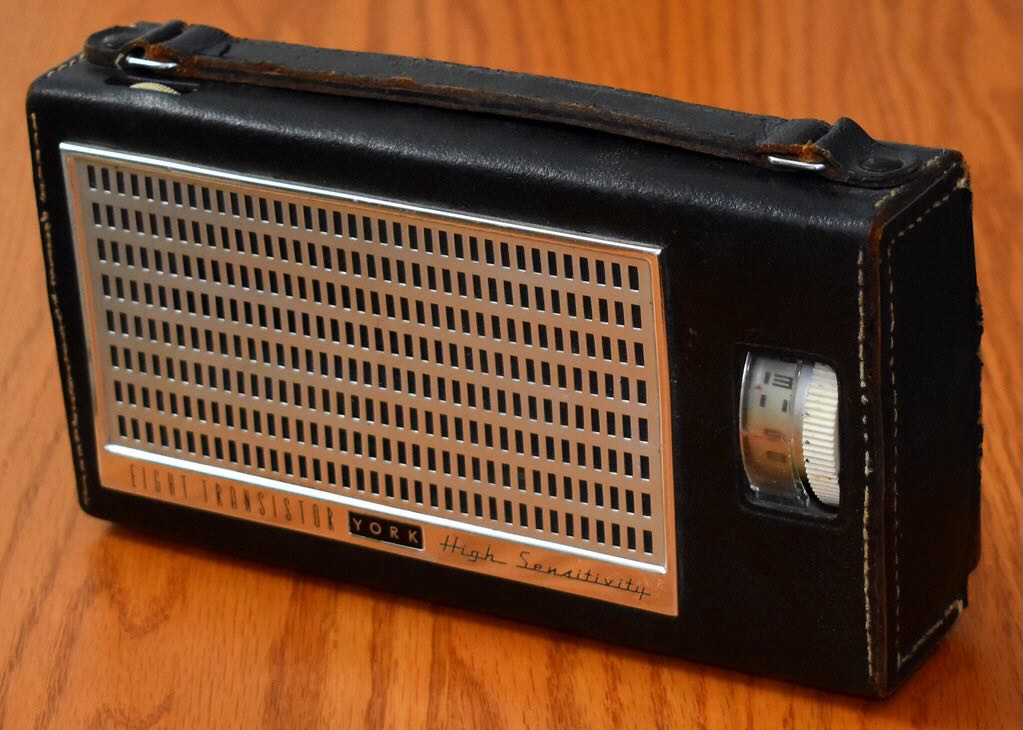 I was entering my teenage years and living in southern Ontario, Canada in relative proximity to the U.S. border, and was immediately fascinated that I could receive American stations from places such as Buffalo and Rochester NY as well as Detroit MI with amazing clarity.
I was entering my teenage years and living in southern Ontario, Canada in relative proximity to the U.S. border, and was immediately fascinated that I could receive American stations from places such as Buffalo and Rochester NY as well as Detroit MI with amazing clarity.
Before long, I discovered that signals from much further afield would begin to come through at dusk and throughout the night time hours. Although I was unaware at the time, many of these would be from so-called “clear channel” stations, those operating on frequencies with the highest level of protection from interference from other stations.
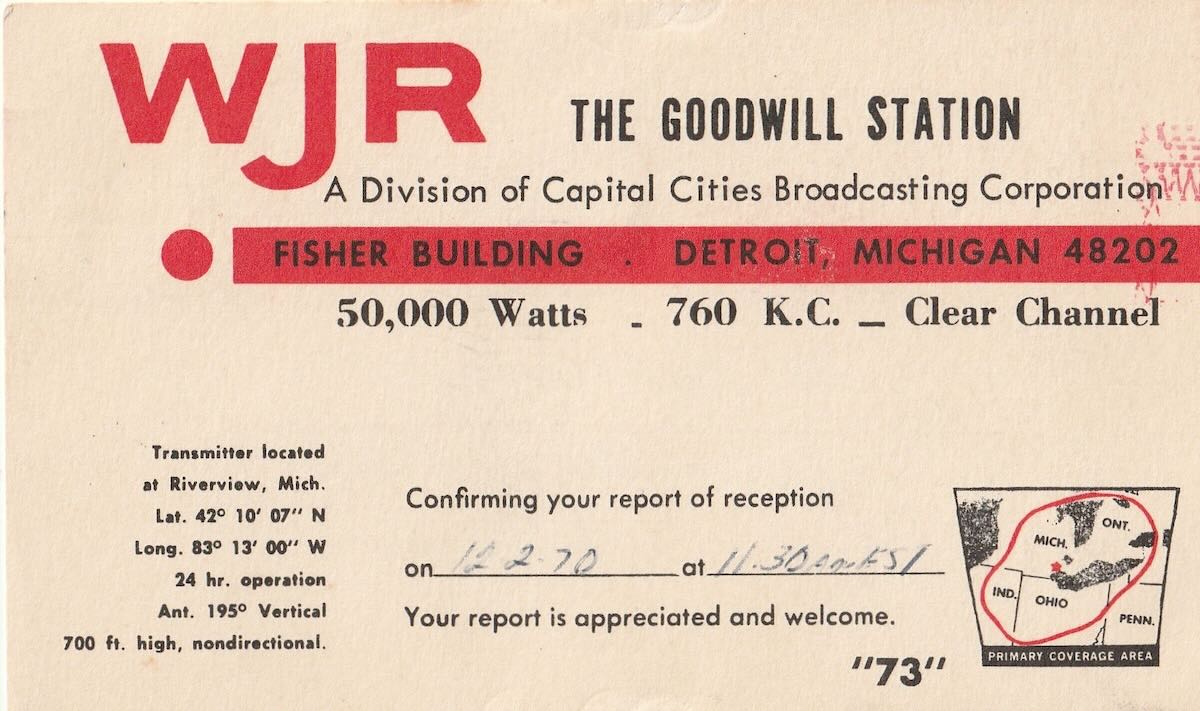 In addition, many of these stations ran a full 50 kw of power. Signals from the Atlantic seaboard to the Midwest could often be heard at near local strength if I turned my radio to just the right angle. At this point, I was beginning to learn about the directional properties of the built-in ferrite rod antenna. It gave me great pleasure to be able to listen to their local ads, newscasts, or a far away sporting event from the comfort of my home.
In addition, many of these stations ran a full 50 kw of power. Signals from the Atlantic seaboard to the Midwest could often be heard at near local strength if I turned my radio to just the right angle. At this point, I was beginning to learn about the directional properties of the built-in ferrite rod antenna. It gave me great pleasure to be able to listen to their local ads, newscasts, or a far away sporting event from the comfort of my home.
I recall listening regularly to WOWO in Fort Wayne IN on 1190 for their play by play announcements of the Fort Wayne Komets hockey games. Then there was a station identifying as WFAA in Dallas. That was back when they shared 820 kHz with WBAP whose famous cowbell you can hear in one of the audio clips below.
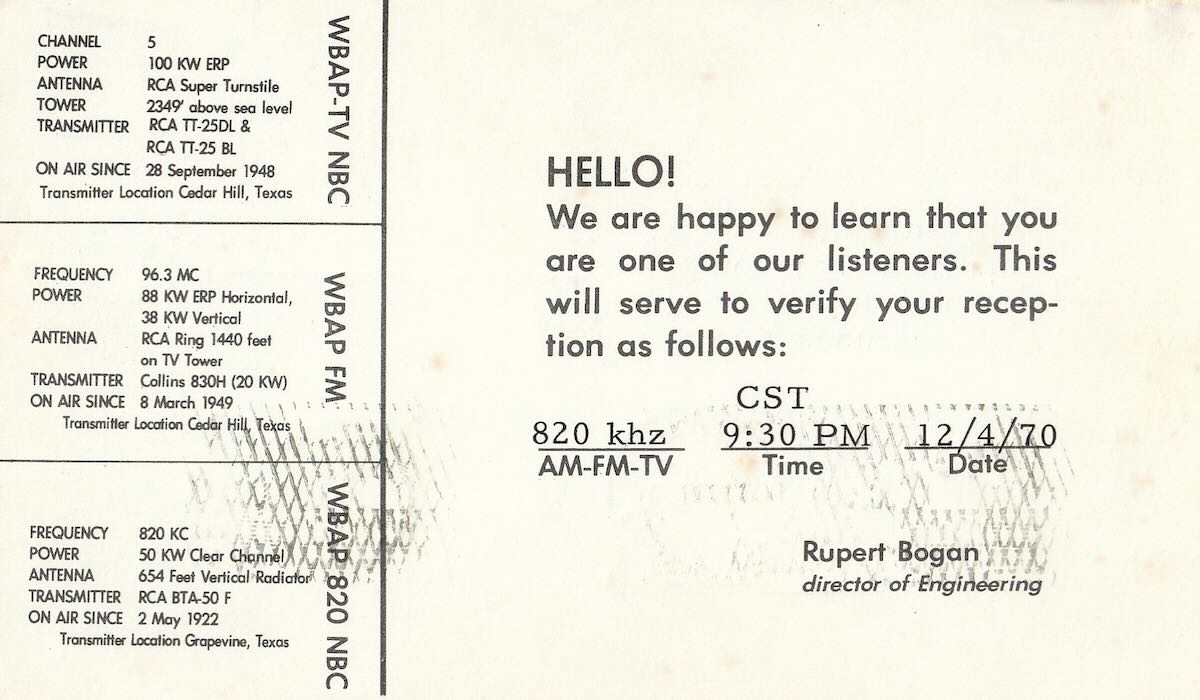 By the end of 1969, a friend of mine had encouraged me to try shortwave, and I “borrowed” my parents Philips kitchen radio for a few months, but that is another story. I wonder how many others got “hooked” in this manner?
By the end of 1969, a friend of mine had encouraged me to try shortwave, and I “borrowed” my parents Philips kitchen radio for a few months, but that is another story. I wonder how many others got “hooked” in this manner?
A few brief recordings of clear channel stations that I made in the early 1970’s are presented here. Many, but not all, of the stations heard in the last two links are from clear channel stations. Reception for these recordings was made using a Realistic DX150A or a Hallicrafters S-52 receiver hooked up to an outdoor long wire antenna.
KFI Circa 1971:
WOAI Circa 1973
KSTP Circa 1970s:
Vintage AM Radio Airchecks 1973:
Vintage AM Radio Airchecks 1973 Part 2:
As a sidebar, the National Radio Club has put out a number of books showing the daytime/nighttime directional antenna patterns of AM broadcasting stations in the USA and Canada.
I gave up my copy from 1973 a number of years ago, but you can find this one and others online. I found this very useful.
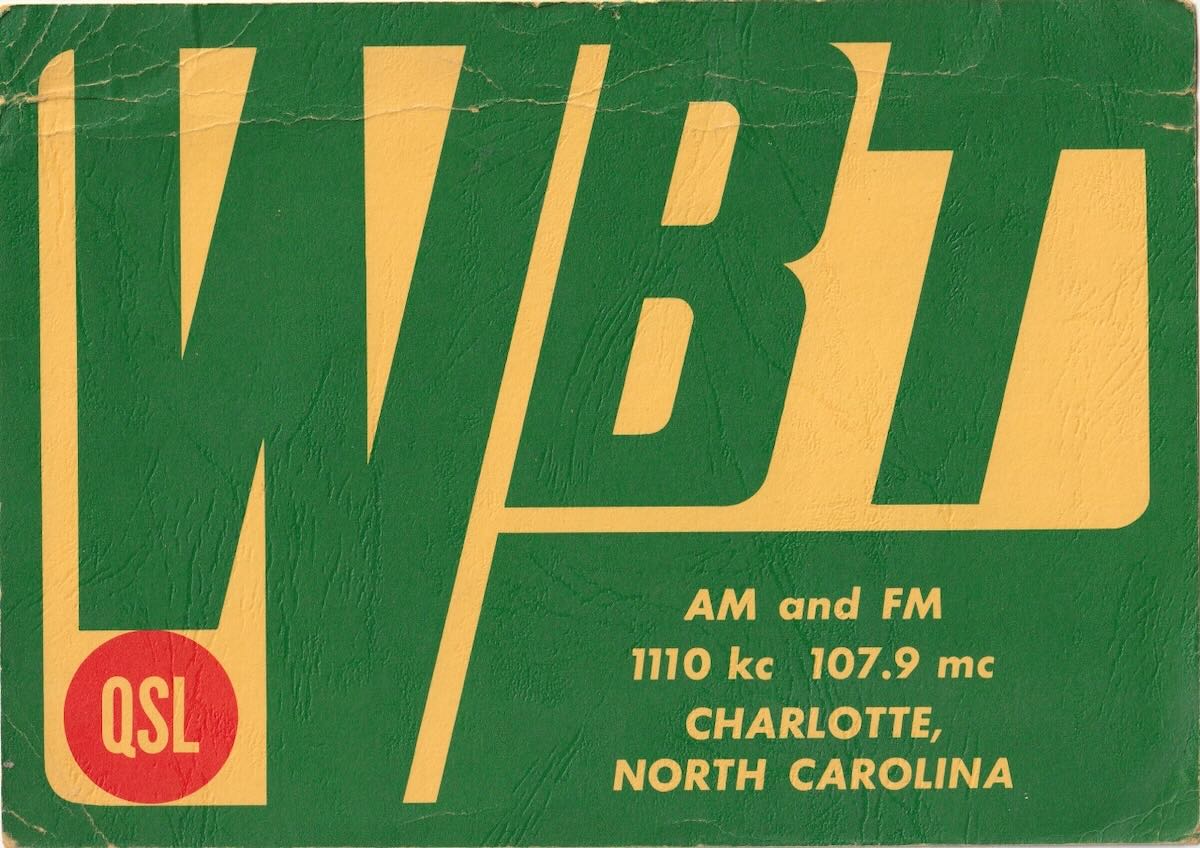 For example, it is easy to see why I was more likely to hear WBT Charlotte NC on 1110 kHz from my listening post in southern Ontario, Canada, rather than KFAB Omaha, NE.
For example, it is easy to see why I was more likely to hear WBT Charlotte NC on 1110 kHz from my listening post in southern Ontario, Canada, rather than KFAB Omaha, NE.
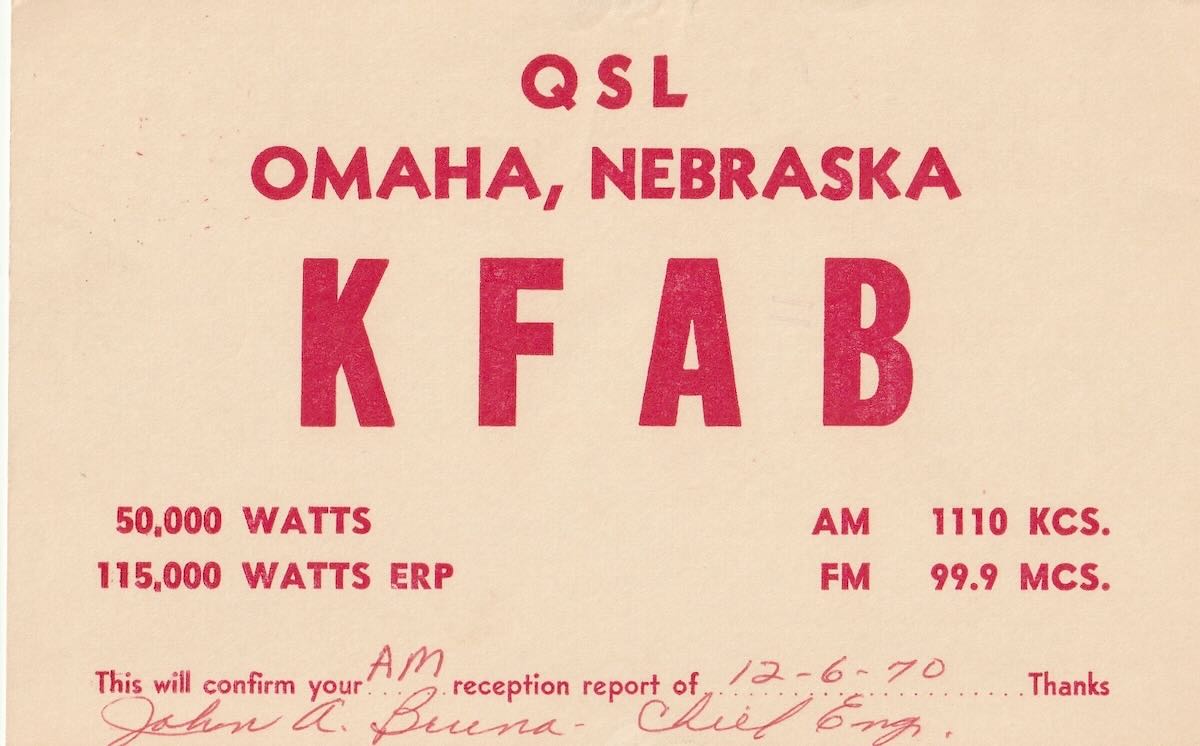 The links below will take you to the 1973, 1975 and 2018 versions of these books.
The links below will take you to the 1973, 1975 and 2018 versions of these books.
https://www.worldradiohistory.com/Archive-Radio-Logbooks/NRC_Logs/NRC-Pattern-Book-First-1973.pdf
https://www.worldradiohistory.com/Archive-Radio-Logbooks/NRC_Logs/NRC-Pattern-Book-8th-2018.pdf

Excellent. I didnt have the WBT QSL in my youth….did have the rest. 1970 age 12 near Chicago the car receiver had beeen on 820 WAIT..daylight only. Coming home from a visit…Dad and I heard good country..then “This is WBAP Ft Wirth-Dallas”…Been MWDXing ever since. Hooked on radio? Yes. 54 years now. 73.
Dan, great story about your interest in radio! I got into shortwave as a teenager in 1977, and also one of my very first QSL cards came from Radio Canada International. I truly miss them!
I have a vivid memory from when I was no more than 5 years old of my father sitting on our front porch on a warm summer evening in Washington DC, with a “portable” GE P780 AM radio in his lap listening to a baseball game in Cincinnati on must have been WLW. There were thunderstorms in the distance and we could hear static on the radio.
I was fascinated. The radio had nothing attached to it, because it was battery powered. And yet there was an announcer in a city 500 miles away telling everyone what was going on in the ball park. How Could That Work? Today, more than 50 years later, I know how most of it works, and yet the fascination I had as a little boy remains.
I still listen to powerful night time stations on MW. But that memory in particular is what fired up my curiosity about radio and later led my Engineering degree and career.
Lovely rhapsodic post Dan!
Reminds me of how I became hooked about the same time when my parents parked an old tube / valve radio beside my bed….
73
Julian
I can so relate to Dan’s comments. I too have lived my whole life in So. Ontario (the Niagara Peninsula to be specific). If you draw a line from Buffalo, NY to Toronto I’m exactly in the middle. As a result there was so much radio to hear and TV to watch. WGR, WKBW, CHUM and CKOC were THE stations for music. And if one was adventurous cruising up and down the dial brought many more stations from a myriad of towns and cities in Canada and the US. So many great memories!
Brings back memories of when we used to receive at least 50 QSL requests from European countries logging WOWO on 1190 kHz in the 1970s. From former WOWO Engineering Manager
Started out building an Allied Radio Corp. Knight Kit “Star Roamer, a regenerative receiver that was a tough, learning experience. Next, a Hallicrafter’s, then, a Lafayette HA-500, great superheterodyne receiver. Nothing compares to the stability of professional equipment. Don’t waste money on anything of lesser quality and reliability. Now have Realistic DX-398.
I remember listening to KFI in AM Stereo back in the late ’80’s in my 1984 Ford Ranger on a Concord HPL-550 deck. Neat stuff driving across the western desert at night experiencing stereo QSB.
Not as intricately involved in DXing, but always a fascinating read as we read here. My first “great” discovery was hearing WGR in Buffalo, from up the road in Rochester. Where we lived, near 4 AM transmitter sites, 550 was wiped out because many of our radios IF sections picked up the local 1460 signal at 550. In the car, the radio pulled in 550 like a local. I then graduated to an Emerson 915, pulling in many of the stations on the airchecks here – and others like 1360 WSAI out of Cincinnati-when the 5kw station a mile from our house was on 1370. Eventually I got to work on, or knew many people who worked on the stations on the air checks. I think you”ll agree that radio seemed a lot “friendlier” sounding back then even with the big voices and every station sounded different. Today we’re faced with “more of the same” on AM, or programming that just doesn’t appeal to the masses. Thanks, Dan, for sharing!!
Thank you, I enjoyed this so much! My radio journey started exactly the same way, with an avocado green Zenith Royal 100 “Zenette”. I really had no idea what to expect from that little receiver, but I was fascinated by the miniaturization and the technology, and I was amazed that I could hear distant radio stations. I believe it was a station in Atlanta that gave me my first taste of “DX”.
When XHDATA announced the D-220 and I saw that it came in green I knew I had to have one! A few days after it arrived I took my radio journey full circle. The D-220 is slightly darker green but almost exactly the same size as the Zenette, and I’m now back living in the same house where I grew up. So one evening I sat down and tuned through the medium wave band and in short order managed to log WBAP (Fort Worth), WSM (Nashville), WTAM (Cleveland), WSB (Atlanta), WBBM (Chicago), WHAS (Louisville), WLS (Chicago), KRLD (Dallas), and WLAC (Nashville).
Dan,
Great article . . . and it’s still fun today. Just last night I was fooling around with a tiny radio and heard a station from South Dakota . . . here is upstate New York.
There’s nothing like the magic of the airwaves, Thanks for sharing.
Cheers, Jock
I was about 15 in 1970, listening to AM late one night about 10 miles west of Boston. Slowly turning the dial I got my first DX catch. WWVA in Wheeling West Virginia, hence the call letters. This was on a Philco AM/FM solid state table radio.
Thanks Dan for the great article. Many of us got our feet wet in the DX’ing world using foreign-made transistor radios and listening at night for distant signals fading in an out and patiently waiting for the station to identify, usualy on the hour or half hour.
I’m still doing AM DX’ing going on 65 years and it’s still a great thrill. I currently use a restored Channel Master 8-transistor “Super Fringe” AM radio from the 60’s. Thanks to you and thank you Thomas. 73’s.
A very interesting story! That was the same way I got into SW DXing, and eventually amateur radio. I started out spinning the dial on my parent’s Zenith console radio in the late 1960s, and later from a small Japanese multi band in my bedroom. Fell asleep to that many times! Good memories …
Dan, that was a great post! Thanks so much for your dedication to recording and saving these! Very cool.